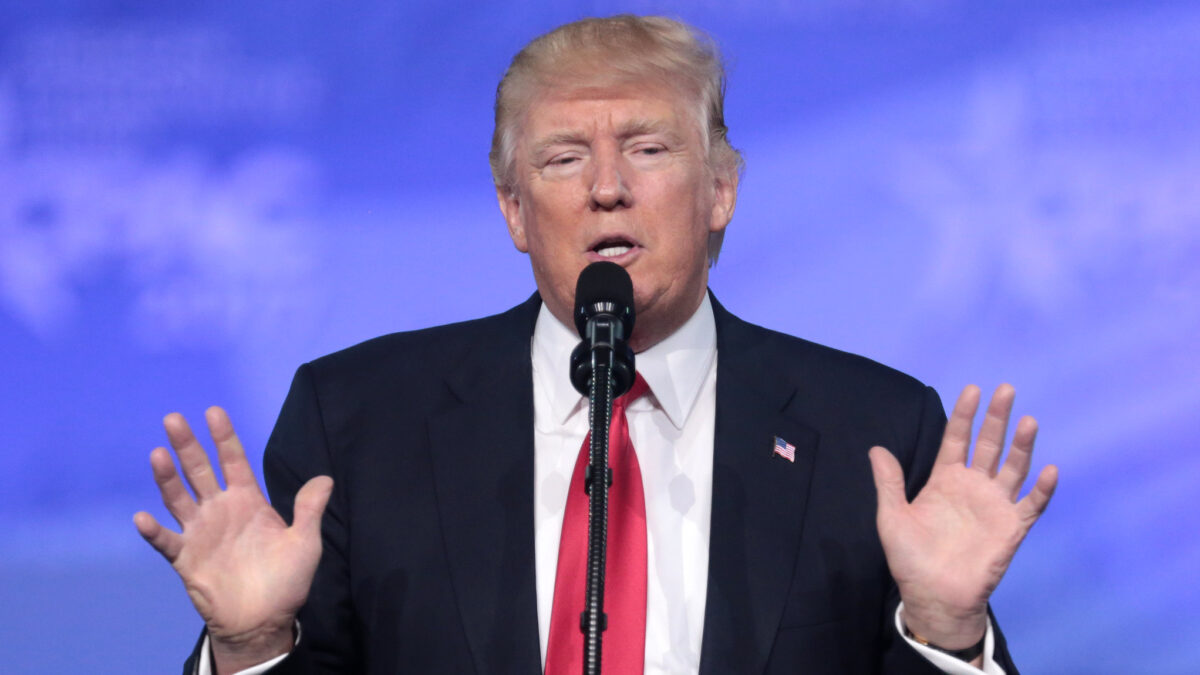
“If you voted for Donald Trump, you are a racist. You have no wiggle room,” tweeted Jemele Hill on July 19. Hill is a writer at The Atlantic and the daughter of a Trump voter. While her contention might puzzle the average American, it would raise few eyebrows on college campuses, where racism and bigotry have been defined differently for years.
Those expanded definitions, so broad they implicate almost everyone, now operate in the institutions populated by graduates of those schools. As a consequence, we are increasingly beholden to a binary system that relies on these broad definitions to categorize people either as progressives or bigots. There is, to borrow a phrase from Hill, “no wiggle room.”
This—the progressive-or-bigot binary—explains our head-spinning summer of “cultural insanity,” from the resignation of a Boeing executive over an innocuous 30-year-old op-ed to the resignation of a New York Times editor over publishing an op-ed by Sen. Tom Cotton (R-Ark.). It explains why the ultra-leftist mayor of Minneapolis was booed out of a protest for disagreeing with calls to defund the police, and why a white woman in expensive yoga pants shouted in the face of a black female cop.
Fernando Martinez is an immigrant and the owner of a Cuban restaurant in Louisville, Ky. When a local Black Lives Matter group sent a threatening letter with a list of demands, Martinez had questions. “How can I be called a bigot and a racist when my family is Black? When my son is gay?” he inquired. “I’m the proud father of a gay son, and I’m gonna fight for him against anybody.”
If you’re scratching your head, wondering how our culture spiraled so quickly, look to the binary. This has been brewing for decades in academia, which has now exported enough graduates into the professional world that cultural arbiters in newsrooms and boardrooms are either intimidated or persuaded into cooperation.
The Theorists
Popular texts written by theorists like Peggy McIntosh, Judith Butler, and bell hooks have been assigned to college students en masse for years. “White Fragility,” a bestseller in the wake of the George Floyd protests, is an obvious extension of this work.
Take McIntosh’s immensely popular 1989 essay, “White Privilege: Unpacking the Invisible Knapsack,” a common assignment in American classrooms. “My schooling,” lamented McIntosh, “gave me no training in seeing myself as an oppressor, as an unfairly advantaged person, or as a participant in a damaged culture. I was taught to see myself as an individual whose moral state depended on her individual moral will.” (A horrifying prospect, indeed.)
“As a white person, I realized I had been taught about racism as something that puts others at a disadvantage,” she writes in the essay, “but had been taught not to see one of its corollary aspects, white privilege, which puts me at an advantage.”
In 2000, bell hooks’s popular “Feminism Is For Everybody” reinforced the same binary. “For example, let’s take the issue of abortion,” wrote hooks. “If feminism is a movement to end sexist oppression, and depriving females of reproductive rights is a form of sexist oppression, then one cannot be anti-choice and be feminist.” Thus if one is anti-abortion, she is anti-feminist, and pro-“sexist oppression.” In this logical formulation, the stakes are much higher than partisan disagreements. Disagreement is oppression.
For hooks, this categorization even extends to her fellow travelers. “Just because they participated in anti-racist struggle did not mean that they had divested of white supremacy,” she insisted. White supremacy, according to this argument, is not merely the noxious ideology of fringe skinheads, it must be unlearned by even the farthest left activists. The definition her work taught millions of students to accept is one that implicates just about everyone. To escape it, you have to accept hooks’s philosophy.
Judith Butler, who’s been applying her work to the Trump era, is also a critical source of academic argumentation for the binary, especially for expanding the definition of violence. Asked by The New Yorker to define the boundaries of violence in February, Butler replied, “The physical blow cannot be the only model for thinking about what violence is. Anything that jeopardizes the lives of others through explicit policy or through negligence—and that would include all kinds of public policies or state policies—are practices of institutional or systemic violence.”
This contention—”Anything that jeopardizes the lives of others through explicit policy or through negligence… are practices of institutional or systemic violence”—explains the ubiquitous “Silence is Violence” signs at recent protests. By this logic, one is either vocal or one is violent. Again, there is “no wiggle room.”
Critical race theory is an important driver of the binary. Here’s a helpful description of the popular academic ideology from The Atlantic:
The school of critical race theory, championed by scholars such as bell hooks, has been around in academic circles for at least 30 years, and its definition of white supremacy has long animated black activism. To quote scholar Frances Lee Ansley (taken here from a passage from David Gillborn, also, a critical-race-theory scholar):
‘By ‘white supremacy’ I do not mean to allude only to the self-conscious racism of white supremacist hate groups. I refer instead to a political, economic and cultural system in which whites overwhelmingly control power and material resources, conscious and unconscious ideas of white superiority and entitlement are widespread, and relations of white dominance and non-white subordination are daily reenacted across a broad array of institutions and social settings.’
Those “daily reenact[ments],” then, are necessarily acts of white supremacy that perpetuate the oppressive system. This is clearly an intentional expansion of the definition, but it also functions as a contribution to the binary, because anyone on the wrong side of the equation is perpetuating oppression, as hooks argued.
Their Contemporary Legacy
“White Fragility” is explicitly predicated on the notion that racism is not restricted to “bad people.” Otherwise decent individuals can perpetuate racism, and are consequently racist. That may seem less insidious, but it encourages the smearing of anti-racist people who happen to disagree with these broad definitions.
When activists Regina Jackson and Saira Rao sought to peddle this ideology on an episode of “The Femsplainers” podcast, their electric clash with hosts Christina Hoff Sommers and Danielle Crittenden progressed into a perfect encapsulation of our tortured racial discourse.
“Dear white women,” Jackson and Rao write on their website, “You cause immeasurable pain and damage to Black, Indigenous and brown women. We are here to sit down with you to candidly discuss how *exactly* you cause this pain and damage. The dinners are a starting point. A place to start thinking through how you actively uphold white supremacy every minute of every day.”
Sommers and Crittenden politely refused to accept the predicate that they uphold white supremacy. Jackson and Rao refused to continue the conversation after discovering this. They hung up. Again, it all comes down to definitions, which insist on a binary that overtly implicates decent people in white supremacy. To people like Sommers and Crittenden and likely most of the country, white supremacy means something very different than Jackson and Rao’s definition, which operates on most campuses and among many of their graduates.
Like “White Fragility,” Ibram X. Kendi’s 2019 book “How To Be An Antiracist” has been a bestseller in the wake of Floyd’s tragic killing. “The opposite of ‘racist’ isn’t ‘not racist,’” Kendi explains, “It is ‘antiracist.’” Consider this passage:
One endorses either the idea of a racial hierarchy as a racist, or racial equality as an antiracist. One either believes problems are rooted in groups of people, as a racist, or locates the roots of problems in power and policies, as an antiracist. One either allows racial inequities to persevere, as a racist, or confronts racial inequities, as an antiracist.
There can be “no neutrality,” Kendi writes. There is “no wiggle room.” Here, again, we see the binary. If people are only racist or antiracist, your ideology is easy to enforce after a certain point of proliferation because corporations, public figures, and average people believe it’s bad for business to be on the side of alleged racism. Academia took care of the proliferation part, now corporations and media are handling enforcement.
Kendi’s rejection of neutrality is a clear articulation of the binary. While his latest book is only one year old, revisiting popular texts from thinkers like hooks, Butler, and McIntosh shows students have been learning to categorize society in the same way for decades. The fruits of that process are now manifest.
The progressive-or-bigot binary, importantly, is even narrower than the title suggests. As the texts above argue, even good progressives can be bigots. To absolve oneself of bigotry, however, every radical aspect of leftist dogma must be embraced.
Interestingly, the binary is fueled by something positive. Individuals accept it because they believe society punishes racism and rewards antiracism. Corporations accept it because they believe markets do the same. This, of course, enables the left’s efforts to redefine these concepts.
It does at least suggest that racism is broadly stigmatized, defined narrowly or otherwise. Implicating decent people in racism and white supremacy, however, could change that, driving confusion, resentment, and discord, all of which are easily exploited by actual bigots.









